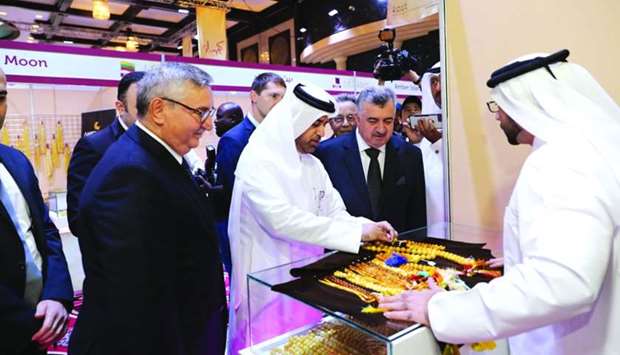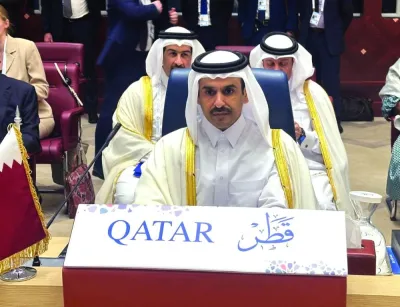The second edition of the Katara International Amber Exhibition at Katara – The Cultural Village was opened Wednesday by general manager Dr Khalid bin Ibrahim al-Sulaiti. A number of diplomats, other dignitaries, and representatives and delegates from the amber industry were present at the event at Building 12.
There are more than 90 stalls at the exhibition featuring participants from 13 Arab and other foreign countries. The exhibition will continue until January 11, from 9am to 1pm and 4pm to 10pm. The participating countries include Turkey, Iraq, Kuwait, Sweden, Lebanon, the UK, Germany, Russia, Poland, Ukraine, Lithuania, Latvia, as well as representatives of associations and international bodies specialising in amber. This is the first exhibition dedicated to amber in Qatar, and the second largest international exhibition on amber ore after the international exhibition held in Poland.

Inaugurating the four-day event, Dr al-Sulaiti said that the exhibition witnessed a remarkable growth in its second year, both in terms of the number of participants from Qatar and outside, and the number of visitors. “This shows that the Katara International Amber Exhibition has succeeded in becoming an important international platform that brings together the most prominent traders, experts and enthusiasts in the field of amber,” he said.
He added that Katara was keen, through this exhibition, to merge the marketing, economic and cultural aspects of amber trade and is offering the rarest types of amber catering to the different tastes of the audience. There are also several activities being held as part of the exhibition. Al-Sulaiti pointed out that the second edition provides an exceptional and distinctive shopping experience, as it constitutes an important forum that brings together merchants and experts in one place.
“We are working through this exhibition to enhance Qatar's position as an international destination for the trade and acquisition of amber, especially as the exhibition has become a preferred destination for global companies.
“The opening of a permanent headquarters for amber through the Katara Center for Amber, and signing a set of agreements to hold training and educational workshops under the supervision of international experts, will further embellish this position.”
Khalid Abdul Raheem al-Sayed, general supervisor of the Katara International Exhibition for Amber, said that the second edition has participation from 13 Arab and foreign countries, while the first edition did not exceed five. “The increase in the number of companies and exhibitors, especially those known for the quality of amber they specialise in, such as from Germany, Poland and Russia guarantee the continuity and uniqueness of the exhibition in the Middle East,” he said.
He said the Katara Center for Amber includes a permanent showroom and laboratory. It will become a meeting place for amateurs and experts and traders from inside and outside Qatar, and thus Katara will become a major station for amber in the Middle East.
Among the distinguished participants in the second edition is Sheikh Talal bin Khalifa bin Abdul Rahman al-Thani, whose pavilion includes rare materials in amber from various sources, like Germany, Poland and India, in addition to ancient and rare beads that do not exist today.
Sheikh Talal bin Khalifa said the pavilion shows his collections over the years. He praised the Katara International Amber Exhibition as it gave amber amateurs an opportunity to view the exhibits of amber lamps and materials from various sources.
Sheikh Mohamed bin Mubarak al-Thani, another participant, said he was impressed by the success of the second edition. There are companies that had to register and wait to obtain a space in the event, which is one of the most successful exhibitions, he said.
He pointed out that his pavilion in the exhibition includes rare stones from the Baltic Sea, Ukraine. The amber stones are designed at specialised workshops in Doha and converted into pebbles and for other uses such as handles of sticks, and previously included women’s jewellery, but in the Gulf region in general the interest is focused on amber lamps.

Some of the amber products on display at the exhibition
Inaugurating the four-day event, Dr al-Sulaiti said that the exhibition witnessed a remarkable growth in its second year, both in terms of the number of participants from Qatar and outside, and the number of visitors. “This shows that the Katara International Amber Exhibition has succeeded in becoming an important international platform that brings together the most prominent traders, experts and enthusiasts in the field of amber,” he said.
He added that Katara was keen, through this exhibition, to merge the marketing, economic and cultural aspects of amber trade and is offering the rarest types of amber catering to the different tastes of the audience. There are also several activities being held as part of the exhibition. Al-Sulaiti pointed out that the second edition provides an exceptional and distinctive shopping experience, as it constitutes an important forum that brings together merchants and experts in one place.
“We are working through this exhibition to enhance Qatar's position as an international destination for the trade and acquisition of amber, especially as the exhibition has become a preferred destination for global companies.
“The opening of a permanent headquarters for amber through the Katara Center for Amber, and signing a set of agreements to hold training and educational workshops under the supervision of international experts, will further embellish this position.”
Khalid Abdul Raheem al-Sayed, general supervisor of the Katara International Exhibition for Amber, said that the second edition has participation from 13 Arab and foreign countries, while the first edition did not exceed five. “The increase in the number of companies and exhibitors, especially those known for the quality of amber they specialise in, such as from Germany, Poland and Russia guarantee the continuity and uniqueness of the exhibition in the Middle East,” he said.
He said the Katara Center for Amber includes a permanent showroom and laboratory. It will become a meeting place for amateurs and experts and traders from inside and outside Qatar, and thus Katara will become a major station for amber in the Middle East.
Among the distinguished participants in the second edition is Sheikh Talal bin Khalifa bin Abdul Rahman al-Thani, whose pavilion includes rare materials in amber from various sources, like Germany, Poland and India, in addition to ancient and rare beads that do not exist today.
Sheikh Talal bin Khalifa said the pavilion shows his collections over the years. He praised the Katara International Amber Exhibition as it gave amber amateurs an opportunity to view the exhibits of amber lamps and materials from various sources.
Sheikh Mohamed bin Mubarak al-Thani, another participant, said he was impressed by the success of the second edition. There are companies that had to register and wait to obtain a space in the event, which is one of the most successful exhibitions, he said.
He pointed out that his pavilion in the exhibition includes rare stones from the Baltic Sea, Ukraine. The amber stones are designed at specialised workshops in Doha and converted into pebbles and for other uses such as handles of sticks, and previously included women’s jewellery, but in the Gulf region in general the interest is focused on amber lamps.



